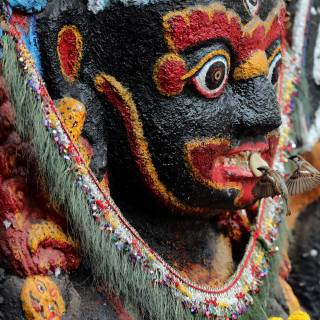Kathmandu, Aug. 24 -- A short story of eleven thousand words-even though short stories are mostly below that word limit-gets turned into a humongous book: Kathmandruids, Peter J Karthak's latest delivery, which is half-fiction, half-nonfiction.
Citing Gao Xingjian in the epigraph, Karthak presents his take on how novels should work, as if to justify his decision to merge the worlds of fiction and nonfiction. He writes that fiction is, in fact, made up of "travel notes, moralistic ramblings, feelings, jottings, unrhetorical discussions, unfable-like fables, some folk songs, your own legend-like nonsense"-all put together in a single bowl, or rather violently yoked together in a glamorous fashion. Yet, the very entropy of ideas makes the novel a supremely experimental one.
Karthak's latest novel relies heavily upon its structure. Written in twenty parts with five Nepal Mandalas-polemical writings about the history of the country and its people-the book draws back its influence upon the circular journey of a monomyth, the archetypal hero. The hero goes on an adventure, struggles against many decisive disasters, is victorious, and returns home transformed. That is the basic premise of the 1871's Joseph Campbell's concept of a monomyth, which was heavily influenced by Carl Jung's view of myth and collective unconsciousness. Contrasting that idea of the monomyths, meanymyths (a neologistic term) takes on minor characters, mostly flat and static, who do not learn any valuable lessons throughout the hero's journey, nonetheless act as foils, deepening the former's character traits and dimensions.
The four major monomyths of the novel, Kathmandruids, are Birendra Bahadur Shahi, Delight Rajya Laxmi Devi Shah-Rana, Purushottam Prasad Pundit, and Maina Devi Pundit. Birendra is the supreme godfather of Nepal, the so-called social equaliser, who has a knack for bypassing laws and minting money out of his criminal deeds. Delight is the founder principal of Delight Academy Nepal (DAN), and she pulls together all the acts in the book. Purushottam, the antagonist, on the other hand, is the secretary of the then His Majesty's Government of Nepal, who keeps freeloading on the spoils of his official positions. His wife, Maina, likewise, always grubs on and gulps down the very spoils brought home by her husband. All these principal characters go on a cyclical journey, at times supporting one another, at others challenging and tempting each other. They all hit rock bottom, go through a metaphorical abyss (death and rebirth) and come out of it transformed, even atoned. Towards the end of the book, they seem to bring the 'gift of goodness' to the world, thus completing a full cycle.
The novel can be compared to Homer's Odyssey or Milton's Paradise Lost. Both these epics begin with the start of the hero's journey of adventure. Kathmandruids, however, begins at the very beginning, with one of the main characters, Birendra, pooping. What follows afterward is several pages of a sermon on peeing and pooping. Since the novel begins with toiletry, it reads like a mock-epic, scorning at the convention. The scatological chapter then leads to the character's daily routine-from jogging to love-making. The readers also get to learn about the daily habits of the other three prime characters. But the palpable joy of being transported to the realm of fiction gets interrupted by seminal articles-of the Nepali mandalas-and the reader might be left exasperating, and wishing to stay more about the fictional world than dwell in the boulevards of scholarly articles.
There's one of the reasons why the author chooses the work to be called a double-helical novel. The two strands of fiction and non-fiction stand as a pair of parallel helices intertwined about a common axis-the backdrop of Kathmandu valley. This beautiful yet uncommon imagery combines the made-up world and its characters to the fact and factoids about the landscape and its real people. The non-fiction part, however, tries too hard to be pedantic at times. Narrated by an alter-ego-like mouthpiece, Swarna Shumsher Jung Bahadur Rana (once an A-class Rana, now a spiritual seeker, a yogi, a sanyasi, who travels around the world, preaching peace and love), these chapters on the history of Kathmandu valley tells a lot, but shows very little. The essays range from commentaries on the Mahabharata to the Medieval Monomyths of Asta Aju of Tham Bahil to Araniko of Patan to the Major Modern Monomyths like Ram Bahadur Limbu, the first Nepali to win a Victoria Cross.
For any query with respect to this article or any other content requirement, please contact Editor at contentservices@htlive.comKantipur Publications Pvt. Ltd